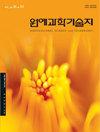小球藻叶面施用对甜瓜生长及采后贮藏特性的促进作用
IF 0.8
4区 农林科学
Q3 HORTICULTURE
Korean Journal of Horticultural Science & Technology
Pub Date : 2023-10-31
DOI:10.7235/hort.20230047
引用次数: 0
摘要
本研究旨在确定适宜的小球藻叶面施用浓度,以促进甜瓜的生长和采后贮藏。250倍和500倍小球藻溶液处理组的SPAD值和叶片数均高于其他处理组。根据叶片数的测定结果,预计小球藻叶面施用对减少落叶现象具有积极作用。鲜重和干重比在未处理的对照组最低,而250倍和500倍小球藻溶液处理组最高。贮藏6天后甜瓜的糖度迅速下降,未处理组甜瓜糖度最低。贮藏12 d后,250倍小球藻溶液处理组果实内部硬度最高,但从第14 d开始,果实内部硬度整体下降。贮藏12 ~ 17 d后,与处理组相比,未处理组甜瓜的外硬度持续下降,且显著降低。500倍小球藻溶液中果实总多酚含量高于其他处理组。250倍小球藻溶液处理的果实游离糖含量高于其他处理组。在小球藻溶液稀释250倍和500倍时,多酚、蔗糖和葡萄糖含量在小球藻处理组中最有效。叶片数在1000倍和500倍时最有效,干重比在250倍和500倍时最有效。内部硬度和白利度在1000倍时最有效。综上所述,综合分析所有实验结果,所有小球藻处理组均表现出比对照组更强的疗效。因此,对甜瓜生长和采后贮藏有积极影响的小球藻可以作为生物肥料补充化肥。因此,小球藻叶面施用可以为消费者提供健康、安全、优质的农产品。本文章由计算机程序翻译,如有差异,请以英文原文为准。
Chlorella Foliar Application Promote Growth and Post-Harvest Storage Characteristics in Melon
This study aimed to determine the appropriate concentration of chlorella foliar application to promote the growth and post-harvest storage of melons. The SPAD values and the number of leaves were higher in the groups treated with 250 and 500 times diluted chlorella solution compared to the other treatment groups. Based on the results of the leaf number, it is anticipated that chlorella foliar application can have a positive effect on reducing the phenomenon of defoliation. The fresh weight and ratio of dry weight showed the lowest values in the untreated control group, whereas the groups treated with 250 and 500 times diluted chlorella solution exhibited the highest values. The Brix of melons rapidly decreased from six days storage, with the fruits in the untreated group showing the lowest values. The internal hardness of the fruits was highest in the 250 times diluted chlorella solution treated group after 12 days of storage, but from the 14th day onwards, it decreased overall. In contrast, the external hardness of melons in the untreated group continuously decreased compared to that in the treated groups after 12–17 days of storage, showing significantly lower values. The total polyphenol content in fruits was highest in the 500 times diluted chlorella solution compared to the other treatment groups. The free sugar content of fruits treated with 250 times diluted chlorella solution was higher than in the other treatment groups. The polyphenol, sucrose, and glucose contents were most effective in the chlorella-treated groups at concentrations of 250, and 500 times diluted chlorella solution, respectively. Leaf numbers were most effective at 1,000 and 500 times, while ratio of dry weight was most effective at 250 and 500 times. And Internal hardness and Brix were most effective at 1,000 times. In conclusion, the comprehensive analysis of all experimental results indicates that all chlorella-treated groups exhibited greater efficacy compared to the control group. Therefore, chlorella, which exerts a positive influence on the growth and postharvest storage of melons, can serve as a complementary biofertilizer to supplement chemical fertilizers. As a result, it is believed that foliar application of chlorella can offer consumers healthy, safe, and high-quality agricultural products.
求助全文
通过发布文献求助,成功后即可免费获取论文全文。
去求助
来源期刊
CiteScore
2.00
自引率
0.00%
发文量
0
审稿时长
1 months
期刊介绍:
Horticultural Science and Technology (abbr. Hortic. Sci. Technol., herein ‘HST’; ISSN, 1226-8763), one of the two official journals of the Korean Society for Horticultural Science (KSHS), was launched in 1998 to provides scientific and professional publication on technology and sciences of horticultural area. As an international journal, HST is published in English and Korean, bimonthly on the last day of even number months, and indexed in ‘SCIE’, ‘SCOPUS’ and ‘CABI’. The HST is devoted for the publication of technical and academic papers and review articles on such arears as cultivation physiology, protected horticulture, postharvest technology, genetics and breeding, tissue culture and biotechnology, and other related to vegetables, fruit, ornamental, and herbal plants.

 求助内容:
求助内容: 应助结果提醒方式:
应助结果提醒方式:


